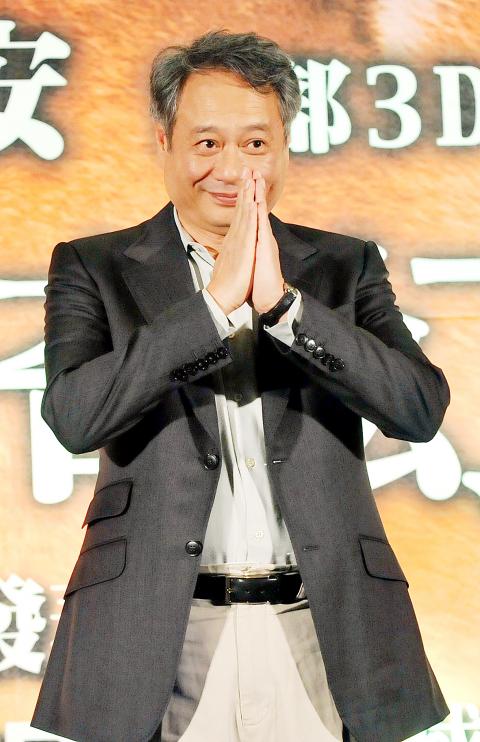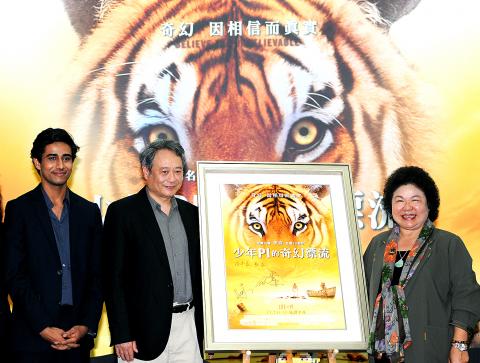Ang Lee’s (李安) Life of Pi hit Taiwan theaters Nov. 21. Adapted from Yann Martel’s international bestseller of the same name, the movie is an adventure tale of a boy who miraculously survives months at sea in the company of a Bengal tiger.
Lee, whose repertoire of films includes Crouching Tiger, Hidden Dragon (臥虎藏龍), Brokeback Mountain, Lust, Caution (色,戒) and Taking Woodstock, returned to Taiwan on Nov. 9 to commemorate the building of the VFX Center, a new high-end filmmaking studio, in Kaohsiung’s Pier 2 district that did much of the film’s eye-catching visuals.
Life of Pi gives life

Photo: Reuters
Prashant Buyyala, managing director of Rhythm & Hues (R&H), the company operating the center which also has facilities in India, Malaysia, Canada and the US, said that Lee’s vision and the movie were the primary reasons why they set it up in Taiwan.
“R&H will train new talent and provide opportunities for the next generation of Taiwanese artists to work on major Hollywood films without having to leave home.” This translates to future creation of 200 jobs for digital artists in Taiwan, he added.
Life of Pi took four years to produce, with 70 percent of it filmed in Taiwan, and involved construction in a former Taichung airport of a 1.7-million-gallon water tank complete with wave machine to simulate being lost in the middle of the Pacific Ocean.

Photo: AFP
The film’s production employed over 14,000 people in several countries. Locals and expats who vied nationwide to be extras in the film were paid about NT$3,000 per day.
“I wondered why we didn’t have such a company in Taiwan. If Malaysia and India can do this, why not Taiwan? So I helped (R&H) set one up,” said the Oscar-winning Lee.
In a forum with Kaohsiung Mayor Chen Chu (陳菊), the film’s now 18-year-old lead star Suraj Sharma and R&H executives, Ang said he chose the special effects company because of its track record.

Photo: Taipei Times
“They’re the best at visual effects,” he said, adding, “I only work with the best companies.”
Setting up the film studio in Taiwan, he said, “is also good stimulus to drive us to be [more] innovative. It’s an issue that needs examination and reflection. The filmmaking industry needs a comprehensive supply chain. That is what is lacking in Taiwan. We need to elevate the infrastructure in Taiwan and equip young people with knowledge,” Lee said.
Initially, Lee had to convince 20th Century Fox executives to support his vision for the film. Fox eventually sign off on the massive US$120 million production costs — a large portion spent on its special effects, using not only the best in CGI (computer generated imagery) but also 3D technology.
Animal madness
R&H collected over 400 hours of stock footage — including thousands of still photos — of animals in Taiwan, France and at an animal trainer’s ranch in Los Angeles. Animators then pored over this material to study every detail regarding “the texture of the animals,” so as to achieve the highest degree of realism.
Although a number of shots in the film use real animals, Berger specified that state-of-the-art animation technologies such as the Cameron Pace System helped capture much of the tiger’s movement, “down to the 10,000 hairs of the tiger … every splay of a paw.”
When asked about the most difficult moment making Life of Pi, Berger said, “Every day is equally different as the day preceding it. It’s not like you’re a painter, where you decide to paint something and do it. It’s like building a skyscraper, involving thousands of people.”
Prashant Buyyala, R&H’s managing director, said that a Taiwan production center was “economically viable,” and “perfect, for now.” In the past, R&H considered opening studios in Europe and China.
The Kaohsiung Connection
“We saw Taiwan as a great destination, and we’ve become big fans of this country,” said Buyyala, “not just because of Ang but because of relationships we’ve built with people here, with students and government officials,” he said, noting Kaohsiung’s beauty, quality of life and low cost of living as particular advantages for its employees.
“Plus the Taiwan government wanted to get into co-production,” and as a global high-tech center Taiwan had both the technology and political will to support development in its creative industries, he said.
Kaohsiung Mayor Chen Chu was thrilled with the new cooperation.
“Kaohsiung used to be a highly polluted city, but now it deserves a chance” to be a player in Taiwan’s budding film industry, she said.
Berger said he found Lee “amazingly gracious. He had a strong vision of what he wanted to see and he stuck to it. He’s a very passionate director and really listens to the people around him for their opinions.”
Erika Burton, R&H’s co-president, added that Lee is inclusive and generous with his time and with his commitments.
“He always takes the time to thank the people who work with him,” Burton said.
Excited about the studio’s construction Lee said, “This is only the beginning. Starting from today, I hope we can see some great work done in Taiwan. I really want to see more cultural collaboration and exchanges.”
Life of Pi is currently playing at cinemas throughout the nation.

On April 26, The Lancet published a letter from two doctors at Taichung-based China Medical University Hospital (CMUH) warning that “Taiwan’s Health Care System is on the Brink of Collapse.” The authors said that “Years of policy inaction and mismanagement of resources have led to the National Health Insurance system operating under unsustainable conditions.” The pushback was immediate. Errors in the paper were quickly identified and publicized, to discredit the authors (the hospital apologized). CNA reported that CMUH said the letter described Taiwan in 2021 as having 62 nurses per 10,000 people, when the correct number was 78 nurses per 10,000

May 5 to May 11 What started out as friction between Taiwanese students at Taichung First High School and a Japanese head cook escalated dramatically over the first two weeks of May 1927. It began on April 30 when the cook’s wife knew that lotus starch used in that night’s dinner had rat feces in it, but failed to inform staff until the meal was already prepared. The students believed that her silence was intentional, and filed a complaint. The school’s Japanese administrators sided with the cook’s family, dismissing the students as troublemakers and clamping down on their freedoms — with

As Donald Trump’s executive order in March led to the shuttering of Voice of America (VOA) — the global broadcaster whose roots date back to the fight against Nazi propaganda — he quickly attracted support from figures not used to aligning themselves with any US administration. Trump had ordered the US Agency for Global Media, the federal agency that funds VOA and other groups promoting independent journalism overseas, to be “eliminated to the maximum extent consistent with applicable law.” The decision suddenly halted programming in 49 languages to more than 425 million people. In Moscow, Margarita Simonyan, the hardline editor-in-chief of the

Six weeks before I embarked on a research mission in Kyoto, I was sitting alone at a bar counter in Melbourne. Next to me, a woman was bragging loudly to a friend: She, too, was heading to Kyoto, I quickly discerned. Except her trip was in four months. And she’d just pulled an all-nighter booking restaurant reservations. As I snooped on the conversation, I broke out in a sweat, panicking because I’d yet to secure a single table. Then I remembered: Eating well in Japan is absolutely not something to lose sleep over. It’s true that the best-known institutions book up faster